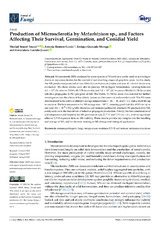Production of Microsclerotia by Metarhizium sp., and Factors Affecting Their Survival, Germination, and Conidial Yield
Autor
Yousef-Yousef, Meelad
Romero-Conde, Antonia
Quesada-Moraga, Enrique
Garrido-Jurado, Inmaculada
Editor
MDPIFecha
2022Materia
Entomopathogenic fungiTemperature
Moisture
UV-B
Soil texture
Resistance structures
METS:
Mostrar el registro METSPREMIS:
Mostrar el registro PREMISMetadatos
Mostrar el registro completo del ítemResumen
Microsclerotia (MS) produced by some species of Metarhizium can be used as active ingredients in mycoinsecticides for the control of soil-dwelling stages of geophilic pests. In this study, the MS production potential of two Metarhizium brunneum strains and one M. robertsii strain was evaluated. The three strains were able to produce MS in liquid fermentation, yielding between 4.0 × 106 (M. robertsii EAMa 01/158-Su strain) and 1.0 × 107 (M. brunneum EAMa 01/58-Su strain) infective propagules (CFU) per gram of MS. The EAMa 01/58-Su strain was selected for further investigation into the effects of key abiotic factors on their survival and conidial yield. The MS were demonstrated to be stable at different storage temperatures (−80, −18, and 4 °C), with a shelf-life up to one year. The best temperature for MS storage was −80 °C, ensuring good viability of MS for up to one year (4.9 × 1010 CFU/g MS). Moreover, soil texture significantly affected CFU production by MS; sandy soils were the best driver of infective propagule production. Finally, the best combination of soil temperature and humidity for MS germination was 22.7 °C and 7.3% (wt./wt.), with no significant effect of UV-B exposure time on MS viability. These results provide key insights into the handling and storage of MS, and for decision making on MS dosage and timing of application.

